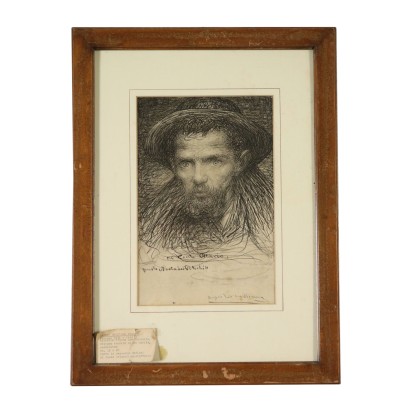Drawing by Angelo Dall'Oca Bianca Portrait of Man 19th Century - Portrait of man with hat
Features
Artist: Angelo Dall'Oca Bianca (1858-1942)
Artwork title: Ritratto d'uomo con cappello
Age: 19th Century / 1801 - 1900
Subject: Portrait/Face
Artistic technique: Drawing
Technical specification: Mixed Technique
Description : Ritratto d'uomo con cappello
Mixed technique on paper. Signed in the lower right corner with dedication - al Conte Ottavio questo "Poeta dei Pitochi" - Angello Dall'Oca Bianca was a humble painter of the Italian and international artistic-cultural environment. He always maintained his relationship with the poor and in 1939 he built a village in Verona for them. In 1941 he wrote his will leaving all his money and paintings to the city of Verona and the poor people. In frame. 19th century.
Product Condition:
Very good condition. Wear consistent with age and use.
Frame Size (cm):
Height: 54
Width: 40
Depth: 2
Artwork dimensions (cm):
Height: 3
Width: 20
Additional Information
Artist: Angelo Dall'Oca Bianca (1858-1942)
Born in Born in Verona from a family of humble origins, Angelo Dall'Oca had to work from an early age as a laborer to support the family, following the death of his father. Encouraged by the fellow citizen sculptor Ugo Zannoni, who became interested in the portrait "My father", Angelo from 1873 to 1876 was able to attend the Cignaroli Academy in Verona, still linked to the traditional subjects of Venetian portraiture and Vedutism. In 1876 he obtained the first appreciation from critics and moved to Venice where he attended free nude courses at the Academy of Fine Arts and the studio of the realist Giacomo Favretto, from whom he also learned the use of photography as a preparatory element of the painting, and added the suffix Bianca to your surname. From that period he began to participate in Italian painting exhibitions. From 1885 he came into contact with the brothers Vittore and Alberto Grubicy, well-known international art dealers based in Milan, who were decisive in encouraging the sales of Dall'Oca Bianca's works and increasing his fame; his presence in the Lombard city also facilitated his acquaintance with Giovanni Segantini, Emilio Longoni and other well-known exponents of the Divisionist current. To complete his pictorial training and consolidate the positive feedback obtained from the critics, he decided to move to Rome where he met people of cultural importance such as Giosuè Carducci, Gabriele D'Annunzio and Francesco Paolo Michetti, with whom he approached the photographic medium that he uses as sketch for the subjects to be transposed on the canvas; in the capital he was introduced to Queen Margherita of Savoy, who commissioned various paintings from him. In this period he participated in the Venice Biennial exhibitions. From 1911, following several attacks by specialized critics and contemporary artists for his painting remained linked to the realist subject, considered no longer current and repetitive, Dall'Oca returned to Verona and withdrew, refusing to participate in the exhibitions, continuing to participate only in the development of culture in his city, fighting for the preservation of its historical heritage. In 1939 the Dall'Oca Village was inaugurated in Verona, built for the benefit of the less well-off of the city thanks to a donation from the painter through the proceeds from the sale of the Ave Maria painting and later expanded with his bequest of 1941. He died in his home in 1942.
Age: 19th Century / 1801 - 1900
19th Century / 1801 - 1900
Subject: Portrait/Face
Artistic technique: Drawing
Il disegno è il processo di tracciare segni su una superficie tramite l'applicazione di una pressione o il trascinamento di un apposito strumento sulla superficie. Gli strumenti sono: matite in grafite o colorate, penna, pennelli fini con inchiostro, pastelli a cera o carboncini; i supporti tradizionali più frequenti sono carta, cartoncino, tavola, muro, tela, rame, vetro.
Technical specification: Mixed Technique






















